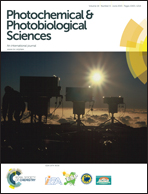Enhancement of antiproliferative activity by phototautomerization of anthrylphenols†
Abstract
An antiproliferative investigation was conducted on 3 human cancer cell lines, HCT 116 (colon), MCF-7 (breast), and H 460 (lung), on a series of 4 anthrylphenols in the dark and upon exposure to light (350 nm). 9-(2-Hydroxyphenyl)anthracene (1) moderately inhibited proliferation, but irradiation considerably enhanced the effect. The other anthracenes 4–6 exhibited antiproliferative activity in the dark, which was not enhanced upon irradiation. The enhancement of the antiproliferative effect on the irradiation of 1 was rationalized as being due to the formation of quinone methide (QM 2) by excited state proton transfer. QM 2 acts as an electrophilic species capable of reacting with biological molecules. Although QM 2 reacts with nucleotides, the adducts could not be isolated. On the contrary, cysteine adduct 8 was isolated and characterized, whereas the adducts with glycine, serine and tripeptide glutathione were characterized by MS. Non-covalent binding of 1 to DNA and bovine serum albumin was demonstrated by UV-vis, fluorescence and CD spectroscopy. However, a straightforward conclusion regarding the DNA or protein alkylating (damaging) ability of 2 could not be drawn. The results obtained by the irradiation of 1 in the presence of DNA, amino acids and peptides, cell cycle perturbation analysis, and in vitro translation of GFP suggest that the effect is not only due to the damage of DNA but also due to the impact on the cellular proteins. Considering that to date all QM agents were assumed to target DNA dominantly, this is an important finding with an impact on the further development of anticancer agents based on QMs.


 Please wait while we load your content...
Please wait while we load your content...